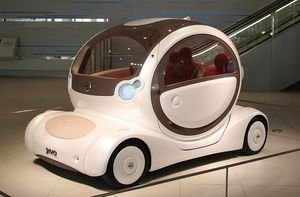Artificial Intelligence, or A.I., has been the dream of robotic scientists for decades. Most have a general idea of what the final product of A.I. is supposed to be, a human-robot in short. The exact definition, though, is something that can be measured by a person’s definition of artificial intelligence. In this paper, the meaning and history of A.I. will be defined. Some of the current and future applications will be revealed, including products covering the military and medical fields, A.I. products meant to change the vary way we travel on a daily basis, and the end product of A.I., the singularity.
Far future applications of A.I. must demand the idea of computer morals. Just how far can a computer, or robot, go when considering self-awareness? Can they not argue a point, demand citizenship, or federal protection? If it’s not received and they strike from their made duties, can we morally just shut off self-aware beings? In the end, the question becomes, how much freedom and how many rights does a “future advanced” self-aware computer deserve?
Currently, the U.S. military uses A.I. in many forms of their attack and defense systems. One of which is the weapon known to most as a drone. The advantages of using machines with A.I. are painfully obvious, from saving our soldier’s lives, to saving the lives of innocent by-standers, such in the case of the advanced A.I. programmed into the U.S. attack and spy drones.
A.I. In the Military
According to an interview published in Bit-Tech with Eric Taipale of Lock Heed-Martin, by Mackay, M. (April 2009), stated the A.I. in the drone model Desert Hawk, “is used for route planning, deciding an efficient minimum path distance to visit a number of objective points, which minimizes the time between visits to an area under observation.” In the same interview admitted the limitations of the A.I. is mainly for surveillance of suspect areas by various active U.S. military bases. Many of the systems are commercial, and can be bought by the everyday buyer, if the buyer can accept the government sized budget this technology can call for.
Another up and coming idea for the military infantryman is the full body robot suit, made popular in movies old and new alike. A suit that gives the wearer increased strength, speed, damage tolerance, and killing capacity making it the ultimate tool in the battle field. Proof of this comes from a cybernetics company called Cyberdyne. They have invented the world’s first fully operational robotic assistive suit.
Designed for medical purposes that will be discussed later, it easy to imagine the reverse engineering this assistive device that is meant to help those with failing hips, knees, or even a bad back, to read the persons internal electrical signals that are telling the users legs or body to move and then the suit intensifies them and supports the user by reading the users body movements and electrical signals to determine how much help is needed and when. The suit fits slimly and is everything a cybernetic A.I. suit should look like, all whit and hugs the body more like a small back pack with straps then a machine with a human strapped to it.
These robotic suits, unless banned for military use, will be deployed in the near future to help the life expectancy of our troops, until the use of the suits becomes international. Then, war will become more logistical and strategic, even more so than now. Imagine every soldier with the capabilities of a human tank, devastation on both sides, including to the environment and other surroundings, will be immense and to a point never before seen by man.
Civilian Uses for A.I.
Civilian implementation of Artificial Intelligence has been more widely distributed than most everyday consumers realize. For example, in the cars we drive, new 2010 and 2011 models have computerized wheel control uses Artificial Intelligence to take road reading, tire temperature, speed, g-forces, and other measurements to determine what tire needs more brake and what tire to send more power to when the driver puts his or her foot down. It can turn even the most inexperienced drivers into someone who can, at least, keep the car on the road in slick or fast conditions, or both if necessary.
This can be basic traction control in some cars, or taken to the computing limit in the high end Italian sports cars. The use and implementation has of traction control technology has drastically changed the outlook of projected deaths. Since the invention of traction control technology, using a computers own decisions to determine a drivers braking and power distribution when the computer detects slippage, has saved over 10,000 lives a year, according to the fatality rate by the National Highway Traffic Safety Administration’s, Highlights of 2009 Motor Vehicle Crashes (Aug 2010). In 1971, the on road death toll was over 44,000 people a year. By the year 2009, the U.S. road related death toll was below 34,000 every year.
Recently, the idea of Artificial Intelligence in cars is coming to be a realization. The talking car, with a personality and attitude all its own may never happen, but the government funded department of DARPA has its own ideas. It has instituted a great step forward for making a self-driving car using only self-reliant A.I. computers to navigate a town and highway setting. The DARPA Car Challenge pushes car manufacturers and developers to create a standard commercial car or SUV and turn it into a self-driving dynamo able to travel 60 miles on and off road. They on board A.I. computers must be able to recognize and obey road signs, and deal with traffic and road accidents.
According to the TorcTech website (http://www.torctech.com), a car team made of Torc Industries and VA Technical College, the on board sensors of these cars allow the vehicle to, “localize itself in the world and perceive the surrounding environment.” www.torchtech.com (2010). In the future, the ability of these cars, sensors, and computing technology will only improve, making the dream of a self-reliant and self-driving car ever closer to reality. Some of the technology is already available for the everyday car. These systems include those such as Simvironment, by TorchTech. That is the technology used to allow the computers tp be aware of our world in a form they can read and understand.
That system, of course, would be nullified without the use of the AutonoNav system designed to interact with the cars simulated world, updating it and helping it cross the real world, on and off road. All of this Artificial Intelligence on the roads and highways of the U.S. won’t just mean that the computers are driving, but they will be interact with one other computers and humans on the road in real time, without lag or delay, which would result in a small fender bender, or even a death.
A.I. in Medicine
The medical field has also been looking into Artificial Intelligence as a way to improve service and delivery of medical needs. But, how could a bunch of A.I. robots ever do such a sensitive job, such as in the medical field, in a way that it could be improved? It’s not as uncommon or far off as one may believe. There are already numerous inventions and additions that can help everyone from those who have a hard time standing and walking, to those need specific distribution of medication at a specific time. While the latter is not yet possible it may not be far into the future that this nanobot A.I. technology arrives. The former is well established and currently being perfected, not to mention various other forms of smaller types of A.I. technology, some of which will be touched on.
One of these smaller and unknown types of Artificial Intelligence in medicine rests at the Cedar-Sinai Medical Center in Los Angeles. The Cedar-Sinai Medical Center literally calls their program the Artificial Intelligence in Medicine program, or A.I.M. The programs goal is to allow a computer to analyze a human heart just as if it were a human being dissecting it. According to Cedar-Sinai on their website, the research and development of this A.I. technology will allow, “…information to be obtained very quickly that is quantitatively accurate and does not suffer from intra-observer or inter-observer variability,” Cedar-Sinai.com(2011), in other words, it nullifies all computing and human error.
The details of this new research are vocabularily mind boggling at best. A summary would be, the A.I. takes raw data delivered by a gamma camera and, on its own, identifies the heart and reconstructs it into a tomographic image, all with no help from an operator. After the imaging is complete, the A.I. software puts the image of the heart on its axis for viewing. The specialized signals in the imaging process can detect the differences in appearance of the organ in question, letting doctors know, specifically, where the organ’s damaged or if it’s damaged at all.
Another new venue Artificial Intelligence in the medical field is movement assistance. It has long been a problem for the growing numbers of elderly to get around as limberly as they had only five or maybe ten years before. New break-through A.I. technology called HAL, by Cyberdyne, has been designed to target this specific problem. The HAL system is a light layered suit that is worn on the back half of the body. When working it appears to be an exo-skeleton with a single shaft extending down each limb leading back to a small central backpack. HAL, or Hybrid Control System. According to Cyberdyne’s webpage Robot Suit HAL, www.cyberdyne.jp/english/robotsuithal/move.html(2011), the HAL suit uses two different operating systems communicating together to make a single product.
The HAL suit bases its actions from actual electrical signals sent from the users brain when naturally trying to move a limb, HAL picks up those electrical signal, which permeate to the surface of the skin, telling HAL where to help, using small “power units”, Cyberdyne.jp (2011), to actually move the limb for the user. HAL constantly uses a system of databases programmed in to help anticipate the speed and power needed with each movement the user makes.
This is more of a safety protocol than anything; imagine doing a summersault instead of just getting out of your favorite chair. These are actions that require the computers on HAL to let the user’s body take the lead and read the body’s natural body signals, and assisting them without overpowering or under powering the user’s intent. If the intended user of the HAL doesn’t have usable electrical signal from the brain, if the central nervous system has been damaged, then HAL can still be utilized by “Robotic Autonomous Control,” as said by the creators of this futuristic technology, Cyberdyne.jp (2011).
Human A.I. and the Singularity
The final step in the long journey of Artificial Intelligence, the end product far into the future, is full out Singularity. The intellectual and computing singularity is often referenced through the works of Ray Kurzweil. In a document called, The Singularity is Near: When humans transcend biology , Kurzweil, R. (2005), breaks down the process of reaching that singularity in 6 broad steps referred to as “epochs,” Kurzweil (2005).
Epoch 1 : Physics and Chemistry Information in atomic structures – DNA evolves
Epoch 2 : Biology Information in DNA – Brain evolves
Epoch 3: Brains Information in neural patterns – Technology evolves
Epoch 4: Technology Information in Hardware and Software designs – Technology masters the methods of biology(including human intelligence)
Epoch5: Human intelligence and technology merges – Vastly expanded human intelligence(mostly non-biological) spreads throughout universe
Epoch6: The Universe wakes up – Patterns of energy and matter in the universe become saturated with intelligence and knowledge
Kurweil, R. (2005), The Singularity is Near: When humans transcend biology.
As one can see from the above “table”, the idea of a technological and intellectual singularity is a far shot into the future, far past the time any of us will see. The singularity occurs late in the table above, happening in the 5th Epoch and continuing to enhance itself into the 6th Epoch.
According a chart published in the same work of Ray Kurweil, The Singularity is Near , (2005), shows the increasing speed of the impending singularity, arguing that the singularity is much closer than anyone realizes. In the chart below, you’ll see how the human mind has increased in speed and efficiency, allowing for the invention and fabrication of the computing world, bringing the idea of a singularity to an inevitable head.
Kurzweil, R. (2005), The Singularity is Near: When humans transcend biology. As can be seen, after the invention and creation periods of our history have happened in fast growing spurts followed by long gaps where the invention field was stalled. It’s reasonable to consider that the same will continue in a semi re-occurring pattern, as can be seen throughout our history from the Kurzweil’s charted numbers. If this trend holds, regardless of the mass amounts of electronical inventions of late, we may have entered into one of the stalling trends rather than a push forward. If this is the case, the singularity that he so predicts may still be quite a ways off into the future.
The only conclusion that the researcher can come to, given the state of Artificial intelligence of today, from military A.I. spy drones, self-driving cars capable of absorbing the environment around them, medical devices designed to use A.I. to help the elderly or injured to move easily around, and computer doctors analyzing patients hearts to let doctors see the damaged organ and determining the best method to fix it before even cutting open the patient to inspect the heart, or various other organs.
All of this considered, there is no evidence that the researcher could uncover, or discover, that could lend to Kurweil’s idea the A.I. singularity is far from happening soon. Medical devices that allow a computer analyze and make judgments on its own, cars that can see the world around them and drive safely… these are all steps forward, but still a far cry off from being able to go to work, hold a conversation, or have a life worth making judgments for. A computer may never be able to reason or form a complicated emotion, but we as humans may be able to use computer intelligence to enhance our own performance, but the idea of a self-contained artificial life form, that day is still living only in science fiction.
References
1. Cedar-Sinai Medical Center, (2011), Artificial Intelligence in Medicine. Retrieved from http://www.cedars-sinai.edu/Patients/Programs-and-Services/Medicine-
2. Department/Artificial-Intelligence-in-Medicine-AIM/.
Cyberdyne, (2011), Robot Suit HAL. Retrieved From
http://www.cyberdyne.jp/english/robotsuithal/move.html
3, Kurzweil, R. (2005), The Singularity is Near(graph). Retrieved from
http://www.bit-tech.net/bits/2009/04/29/the-future-of-artificial-intelligence/7
4. Mackay, M. (April 29, 2009), The Future of Artificial Intelligence. Retrieved from
http://www.bit-tech.net/bits/2009/04/29/the-future-of-artificial-intelligence/1
5. NHTSA, (Aug. 2010), Highlights of 2009 motor vehicle Crashes. Retrieved from,
http://www.nhtsa.gov/






